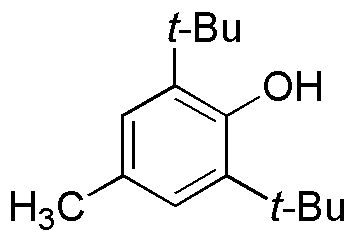2,6-Di-tert-butyl-4-methylphenol is widely utilized in research focused on:
- Antioxidant Applications: This compound is primarily used as a powerful antioxidant in various industrial products, helping to prevent oxidation and extend the shelf life of materials like plastics, rubber, and fuels.
- Food Preservation: In the food industry, it acts as a food preservative, protecting oils and fats from rancidity, thereby maintaining flavor and quality in packaged foods.
- Cosmetics and Personal Care: It is incorporated into cosmetics and personal care products to enhance stability and prevent degradation of sensitive ingredients, ensuring product efficacy over time.
- Pharmaceuticals: The compound is used in the formulation of pharmaceuticals, where it helps to stabilize active ingredients, improving the overall effectiveness and safety of medications.
- Polymer Manufacturing: In the polymer industry, it serves as a stabilizer, protecting polymers from thermal degradation during processing and extending the lifespan of finished products.
General Information
Properties
Safety and Regulations
Applications
2,6-Di-tert-butyl-4-methylphenol is widely utilized in research focused on:
- Antioxidant Applications: This compound is primarily used as a powerful antioxidant in various industrial products, helping to prevent oxidation and extend the shelf life of materials like plastics, rubber, and fuels.
- Food Preservation: In the food industry, it acts as a food preservative, protecting oils and fats from rancidity, thereby maintaining flavor and quality in packaged foods.
- Cosmetics and Personal Care: It is incorporated into cosmetics and personal care products to enhance stability and prevent degradation of sensitive ingredients, ensuring product efficacy over time.
- Pharmaceuticals: The compound is used in the formulation of pharmaceuticals, where it helps to stabilize active ingredients, improving the overall effectiveness and safety of medications.
- Polymer Manufacturing: In the polymer industry, it serves as a stabilizer, protecting polymers from thermal degradation during processing and extending the lifespan of finished products.
Documents
Safety Data Sheets (SDS)
The SDS provides comprehensive safety information on handling, storage, and disposal of the product.
Product Specification (PS)
The PS provides a comprehensive breakdown of the product’s properties, including chemical composition, physical state, purity, and storage requirements. It also details acceptable quality ranges and the product's intended applications.
Certificates of Analysis (COA)
Search for Certificates of Analysis (COA) by entering the products Lot Number. Lot and Batch Numbers can be found on a product’s label following the words ‘Lot’ or ‘Batch’.
*Catalog Number
*Lot Number
Certificates Of Origin (COO)
This COO confirms the country where the product was manufactured, and also details the materials and components used in it and whether it is derived from natural, synthetic, or other specific sources. This certificate may be required for customs, trade, and regulatory compliance.
*Catalog Number
*Lot Number
Safety Data Sheets (SDS)
The SDS provides comprehensive safety information on handling, storage, and disposal of the product.
DownloadProduct Specification (PS)
The PS provides a comprehensive breakdown of the product’s properties, including chemical composition, physical state, purity, and storage requirements. It also details acceptable quality ranges and the product's intended applications.
DownloadCertificates of Analysis (COA)
Search for Certificates of Analysis (COA) by entering the products Lot Number. Lot and Batch Numbers can be found on a product’s label following the words ‘Lot’ or ‘Batch’.
*Catalog Number
*Lot Number
Certificates Of Origin (COO)
This COO confirms the country where the product was manufactured, and also details the materials and components used in it and whether it is derived from natural, synthetic, or other specific sources. This certificate may be required for customs, trade, and regulatory compliance.


